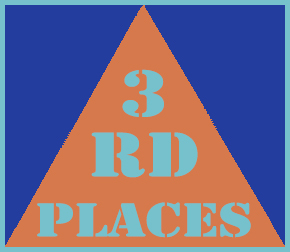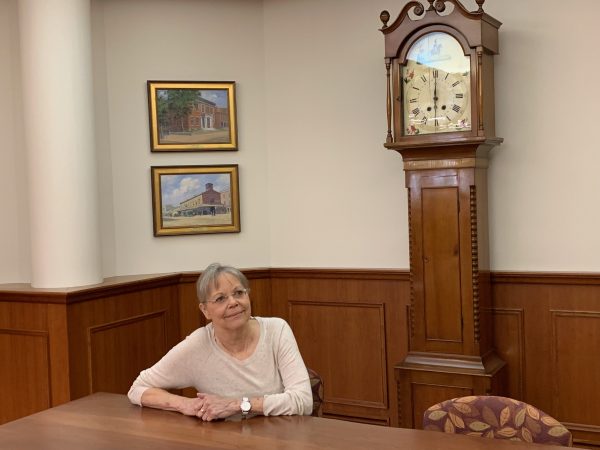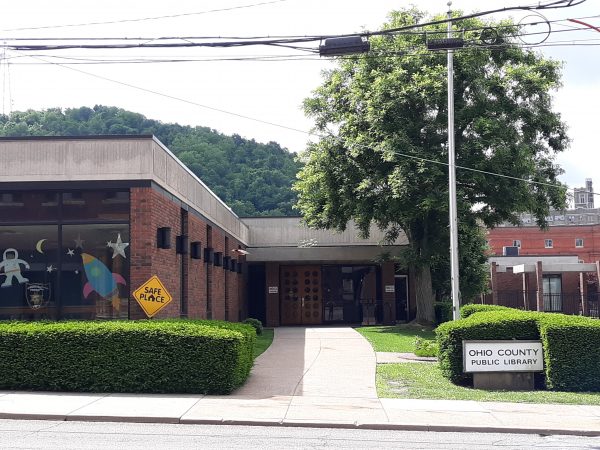Author’s note: In his work, The Great Good Place, urban sociologist Ray Oldenburg coined the term “third place” to define public social settings where locals regularly gather in safety for conversation, connection and a sense of home away from home. Although we all yearn for shelter and meaningful employment, third spaces address another basic need — they connect us to each other and foster democratic instincts among the local community. It’s tempting to perceive these havens as vanishing ideals, but this series guides you on a journey of discovery through Wheeling to show that third place living is alive and well at a street corner near you. Today, we check out the Ohio County Public Library.
 s public library. (Serves me right for propping my feet up on one of the chairs near the comic books!) Minutes later, security kindly advised me to adjust my posture. The gentle reminder paradoxically emphasized the safety of a place that services all walks of life — students, homeless/displaced persons, the elderly, professionals, energetic toddlers, tired moms — anyone seeking communion with books and people.
s public library. (Serves me right for propping my feet up on one of the chairs near the comic books!) Minutes later, security kindly advised me to adjust my posture. The gentle reminder paradoxically emphasized the safety of a place that services all walks of life — students, homeless/displaced persons, the elderly, professionals, energetic toddlers, tired moms — anyone seeking communion with books and people.
The Ohio County Public Library models an overlooked feature of third places — safety. An environment’s threat level is one of the first things we subconsciously assess before lingering. In the great hierarchy of needs, safety represents a strong and primitive motivation. Furthermore, while third places can tolerate and even thrive in a physically unadorned setting, a lack of physical security is an interpersonal nonstarter. Third places must strike a balance between looking too brand-spanking new and seeming too seedy, run-down or threatening. These sensibilities led the Ohio County Public Library to wisely update its look a couple of years ago with brighter lighting, newer ceilings and other cosmetic updates in order to cultivate a more inviting social habitat.
Because healthy social interaction begins with physical safety, it made sense to launch our third places journey at the Ohio County Public Library. Dottie Thomas, the library’s director, graciously sat down with me to explain how the library staff nurtures a third space teaming with social connection. There in the silence of the Wheeling Room, flanked by genealogy records, Thomas revealed to me the staggering lengths to which the library goes to build complex, intentional community.
THE MANY ROLES OF THE OHIO COUNTY PUBLIC LIBRARY
Spend a hot minute around Thomas’, bespectacled, feisty enthusiasm for education, and you, too, will be inspired. As a native of the Ohio Valley, Thomas recalled beginning her vocation at this library: “I started my career as the children’s specialist, then went to Pitt [University of Pittsburgh] and got a degree.” Though her talent led her out of state for a time to Pittsburg, Kansas, where she first served as a library director, Thomas eventually returned to Wheeling and her current capacity.
Throughout her career, Thomas witnessed the limitations of electronic circulation and other internet resources, and her observations underscored the importance of human connection in library service. National trends emerged: over the last five years, library circulation has been shrinking, yet the quantity of library programs has grown twice as fast. Library patrons across North America now check out fewer items but come for more scheduled events.

Thomas’s library management strategy emphasizes human factors in each of its five core roles, which include (1) providing reading/recreational materials for the community, (2) supporting education, (3) coaching patrons in accurately accessing information, (4) serving as a “a place to collect, archive and store the community’s local history and culture, and then make it available to the public,” and (5) functioning as a “community center.” In particular, Thomas recalled an intentional library decision to forgo the use of automated check-out stations in order to preserve the personal connection at the front desk. Additionally, because fewer students now visit, library staff now distributes books directly to schools and visit schools to engage with students there as well.
Library work extends well beyond assisting the community with accessing information. For example, the staff proactively coaches patrons as they acquire, navigate and interpret the resources available to them. According to Thomas, “That’s what a good library does — guide you to good sources of information.” Doing so also means maintaining a running, written record of all the reference questions that staff members are asked in order to better understand their guests’ needs. It also means defending intellectual freedom by educating others about the American Library Association’s Library Bill of Rights. Social connection, for Thomas, translates into both a democratic public service and a competitive advantage over the internet, where quality of sources can be dubious and interpretive guides few.
The internet lacks other capabilities that the library holds in spades. For instance, the internet struggles to render three-dimensional objects tangible, while the library’s drive to display 250 local artifacts helps Wheeling history come alive. Additionally, the internet can be divisive, whereas the library unites others through recurring weekly events and educational activities like Lunch With Books or the People’s University. For Thomas, books, data and information are only as good as their curators.
And that’s the point. In a third place like a library, proper stewardship of the written word necessitates social engagement: “A library really should be a place where the people gather together.” From checking out a book to attending a programmed event, education flourishes amid relationships.
WHAT MAKES THE OHIO COUNTY PUBLIC LIBRARY A THIRD PLACE?
After describing the library’s key roles, Thomas and I reflected on how it works as a third place. The library intuitively seemed to have the right stuff, but I wanted to suss out specifics. Here they are:
Third places represent a neutral ground. As we talked, Thomas used journey language to articulate how librarians “guide” us to “navigate information.” However, one travels at one’s own pace. There’s no pressure be a certain way or achieve a specific standard — just be here now. Not all who wander are lost … especially in a library.
Third places are levelers. On this, Thomas was adamant: “Public libraries don’t judge … their role is to provide information for all sides of the issue.” For her, “you don’t have to have money, you don’t even have to have a home” to access library resources — they bear a special burden as “the only democratic institution.” Out of all the third places that contribute to healthy democratic societies, libraries remain at the vanguard.
Conversation is king. Can you really talk that much in a library? Thomas thought so. I let her count the ways. There were book discussion groups. Games of chess. “Lunch With Books.” “The People’s University.” That’s the short list. Most of the time patrons are huddled around tables in twos and threes, murmuring in hushed tones. Or chatting up the staff behind the front desk.
 Ease of accessibility makes fending off loneliness easy in a third space. At first, Thomas was a little uncertain about the library’s accessibility. Her standard for accessibility meant reaching the entire population of Ohio County. I appreciate her standard, but trust me. The library is only a couple of blocks from the Intermodal Center on Main Street. It is easy to find.
Ease of accessibility makes fending off loneliness easy in a third space. At first, Thomas was a little uncertain about the library’s accessibility. Her standard for accessibility meant reaching the entire population of Ohio County. I appreciate her standard, but trust me. The library is only a couple of blocks from the Intermodal Center on Main Street. It is easy to find.
The regulars make a third space come alive. Abundant weekly programming truly brings this literary community to life. Regulars will arrive hours early for the “Lunch With Books” group to chat with their friends. Did you know that you could get away with that? Me neither! How cool is that?
Third spaces are often unassuming or have a low profile. Easily overlooked amid downtown Wheeling’s topography, this utilitarian brick one-story remains unadorned by steeples, ornate stonework or smart minimalist design. However, it is a solid, reliable bulwark. Libraries are structurally heavy buildings, Thomas explains, because they support the weight of thousands of books. In fact, the library’s original design emerged with the option of additional floors in mind. As such, this edifice becomes the sturdy “everyman” of architectural establishments, beckoning you to linger within its sturdy, protective shelter.
The mood is playful. Thomas didn’t need to convince me. One look at the kids’ section confirmed centrality of play in this environment. A robust graphic novels section sealed the deal. And did I mention the programming? Madcap Puppets anyone? Or eight free classes on Wild, Wonderful & Weird Wheeling? This is why the regulars keep coming — for the initiated, library time is magic time.
… library time is magic time.
Third spaces offer a sense of “home away from home.” Taken in total, one sees why many patrons have returned, week in and week out. Come long enough, and the library possesses you with its subtle sense of place. For some, this environment may be the only sane corner of town where one feels as though one belongs. In offering us a physical center around which we organize our migratory patterns, the Ohio County Public Library “roots” us to the community.
DOTTIE THOMAS AND THE CULTIVATION OF THIRD PLACES
In their own quiet and unassuming way, the gentle souls staffing our library downtown have heroically labored at the front line of public service to forge a rich social microcosm out of countless wild and woolly visitors. How can other local groups and establishments accomplish this alchemy? Did Dottie Thomas have any pro tips for the rest of us?
Ever the pragmatic, Thomas offered up practical recommendations. “Keep the spaces pleasant,” she observed. “They have to be safe.” For her, municipal infrastructure nurtures the safety and accessibility of growing third places. “The city has to work on keeping all neighborhoods safe and physically attractive. Pay attention to traffic flow, good sidewalks, streets in good condition.”
As I glanced around the library one last time, Thomas’s logic was compelling. We do not need to be the fanciest or the cleverest to be present for each other. However, we do need to help others feel safe — physically, emotionally, politically. In every way, the Ohio County Public Library nails it.
So … graphic novels, anyone?
• Phil Gable is a psychologist, veteran and Army Reservist with a history of one deployment to Afghanistan. Despite growing up in Kennesaw, Georgia, he likes to think of himself as having “married into” the Ohio Valley where his wife grew up. He is a graduate of Georgia Institute of Technology, Georgia State University and Fuller Theological Seminary, where he completed his doctor of philosophy in clinical psychology. When not shamelessly navel-gazing or sipping bourbon, he likes to pursue hobbies such as writing, reading and running. Phil considers Wheeling the perfect place to do all of these things, and can occasionally be found hiding out in the comic book section of the library downtown.


